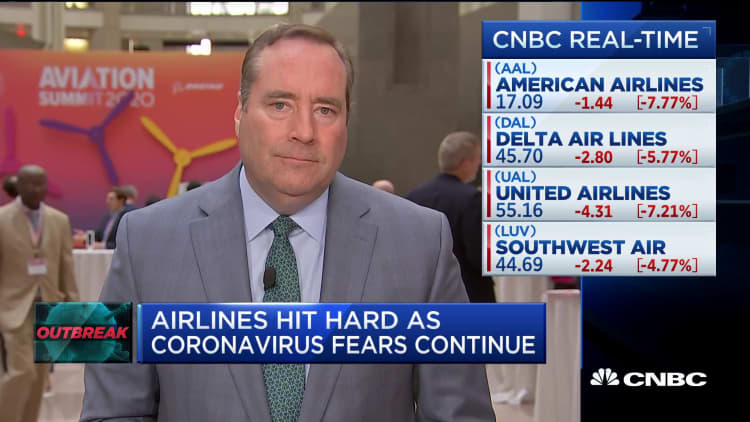Airline stocks have been pounded even worse than most of the stock market in recent weeks, falling 30% as fears that the new coronavirus will lead to mass customer defections roil their world. It's gotten so bad that United Airlines canceled an investor day set for March 5, saying the COVID-19 issues meant United wouldn't get any attention for the long-term plan it wanted to pitch.
But for a combination of reasons, American carriers may be more resilient than they appear, that is, if the global health crisis doesn't last too long or spread too widely. If it does, airlines' high fixed costs will mean profits get hit hard by even medium-sized drops in revenue. And weaker carriers overseas will get hit harder: British regional carrier Flybe announced today that it is going into the British equivalent of bankruptcy court, though it had serious issues before the coronavirus outbreak.
The two biggest reasons to be guardedly optimistic are that U.S. carriers came into the crisis in good shape, and that during it, the price of airline fuel has been crashing, cutting one of their biggest expenses. Energy consultant IHS Markit now expects that Q1 2020 world oil demand will decline by the largest volume in history — even exceeding the declines during the 2009 financial crisis. OPEC has agreed on a massive supply cut, though Russia has yet to agree, as Brent crude prices trade around $50 and WTI crude below that.
Until as recently as last week, airlines thought the drop in fuel alone was offsetting lost business from Asia, but with the virus spreading to Europe and making inroads in North America, fewer investors are willing to make the short-term bet that costs can fall faster than revenue.
Just today, Southwest Airlines announced that business has plummeted in the last week, enough to force Dallas-based airline to cut first-quarter revenue guidance by $200 million to $300 million, about a 5% drop. This follows a move yesterday by Chicago-based United Airlines Holdings to cut 10% of its domestic flights and 20% of its international routes due to lower demand. But Southwest's filing also says cheaper fuel will save it $1 billion this year, giving it a cushion against falling profits.

Sentiment has turned sharply on airlines over the last three weeks, and even in the last few days.
As recently as Feb. 11, Moody's Investor Service issued a report stating fuel prices alone were more than offsetting the impact of business lost from cancelling flights to Asia. But on Thursday, the International Air Transport Association is sending up an alarm, arguing that coronavirus could make industry revenues plunge worldwide by $63 billion to $113 billion this year. Two weeks ago, IATA thought that number would be $29 billion, and the impact limited to airlines operating in "markets associated with China."
"There are lots of airlines that have got relatively narrow profit margins and lots of debt, and a cash flow shock like this could certainly send some into a very difficult situation," IATA Chief Economist Brian Pearce told reporters in Singapore, according to Reuters.
Moody's analyst Jonathan Root says the more recent news is threatening.
"All bets are off if this becomes a widely dispersed virus,'' he said in an interview Wednesday night.
Airline CEOs' meeting with Trump
Airline chief executives met at the White House Wednesday with President Donald Trump, letting each side brief the other on preparations to cope with the virus. Vice President Mike Pence told the group that passengers on remaining flights from Asia are being screened before entering the U.S., while the president blamed his predecessor Barack Obama for imposing regulations Trump claims made it harder rapidly to develop coronavirus test kits.
"That was a decision we disagreed with, I don't think we would have made it, but for some reason it was made but we've undone that decision,'' the president said.
After the meeting, CNBC's Eamon Javers reported that the CEOs privately cautioned White House officials not to speak in a way that discouraged people from flying. They urged White House Chief of Staff Mick Mulvaney to "talk up the facts, not the fear," Javers reported, citing a person familiar with the conversation.
The NYSE ARCA Airline Index has dropped more than 30% since Feb. 12 as fears of coronavirus have spread. Among the biggest drops: American at 40% and Spirit Airlines' 39% drop. Southwest, which doesn't have flights to Europe or Asia, is down 21%. Alaska Air is down 27% and Delta is down 23%, while United at 28% and JetBlue Airways' 26% decline are near the middle.
How to analyze an airline financially
Airlines are fairly simple to analyze financially, so the reasons for the caution aren't hard to figure.
Airlines have such high fixed costs for planes and staffing that even a small loss in business causes a much bigger gap in profitability, since carriers pay as much to run a half-full flight as one that is 84% full, the industry average last year, said CFRA Research analyst Colin Scarola. Until recently, U.S. airlines' planes were much more full than they used to be. The 84% average "load factor" in 2019, according to U.S. Department of Transportation data, was up more than 10 percentage points from 15 years ago.
Preliminary government data for January suggests passenger traffic was up 5% from a year earlier.
Then things apparently began to crack in February, but no one knows for sure, Root said. At Southwest, the crack has happened just in the last week, the company said in an SEC filing today.
"The Company experienced healthy passenger booking and revenue trends for the first two months of 2020, with year-over-year increases in operating revenue per available seat mile (RASM) that were in line with the Company's expectations," the filing said. "However, in recent days, the Company has experienced a significant decline in customer demand, as well as an increase in trip cancellations, which is assumed to be attributable to concerns relating to reported cases of COVID-19."
The biggest thing that makes revenue change is how full planes are, and their biggest costs are fuel and labor. Fuel represents 15% to 20% of airline costs, according to U.S. government data. The price of fuel has dropped 33% since Fall 2018, according to the U.S. Energy Dept., half of that since December.
Even though airline and balance sheets and recent free cash flow trends may look great, things can change in a hurry.Colin ScarolaCFRA Research analyst
United is one example of how airlines have been planning to cope. In a Securities and Exchange Commission filing Feb. 28, the Chicago-based carrier said the impact of lost international business in the first quarter was likely to be offset by fuel costs and payments under a renewed credit-card partnership with JPMorgan Chase. But United also withdrew its 2020 guidance, saying the range of potential outcomes was too wide to make any forecast viable. If COVID-19 runs its course by May, United said, it would be likely to meet its previous forecast of profit between $11 and $13 per share. United's stock currently trades around $56.
"The company remains confident in its long-term outlook, including the 2022 adjusted diluted earnings per share range, [and its] 2022 and 2023 adjusted free cash flow targets [announced on] Feb. 24," United said in the filing.
Certainly, airlines have done very well recently, with big profits and even bigger cash flow, plus manageable debt loads.
Notwithstanding IATA's assessment that many global carriers are shaky, big U.S. airlines earned $335 million (at Spirit) to United's $3 billion in net income last year. Also, thanks to heavy non-cash expenses such as depreciation, reflecting the gradual writedown of airplanes — mostly, for accounting purposes — operating cash flow is even better. That ranged from $1.44 billion at JetBlue up to $6.9 billion at United.
Most U.S. airlines have about $3 billion in cash on their balance sheets, with the smaller Spirit and JetBlue having $1.1 billion and $1.3 billion respectively, as of Dec. 31.
Debt is not a problem for most major U.S. carriers, especially with low interest rates. The average airline has 15 times the cash flow it needs to cover interest payments, CFRA Research's Scarola said. Indeed, American was able to sell $500 million in debt at full value as recently as Feb. 20. But Scarola did sound a note of caution about American, whose cash flow is only about four times its interest burden.
Nonetheless, Scarola recently cut his investment rating on United, American and Delta stock to hold from buy or strong buy. To Scarola, the problem is that airlines' high fixed costs mean any drop in business will almost immediately cause outsized impact on profits.
At American, where he expected the impact to be limited until recently because it has few flights to Asia, a 10% to 15% revenue decline could wipe out net profits, he calculates. Delta is vulnerable because more than a quarter of its revenue comes from international flights, mostly to Europe. He expects United to hold up relatively well, but cut his 2020 profit forecast $1.30 a share to $11.45.
"Even though airline and balance sheets and recent free cash flow trends may look great, things can change in a hurry if demand abruptly declines," Scarola said in an email.
For now, the math for big U.S. carriers points to smaller revenue declines than the double-digit drop that would erase profits for some airlines, with fuel savings undoing much of the damage. How long that lasts is anyone's bet.






